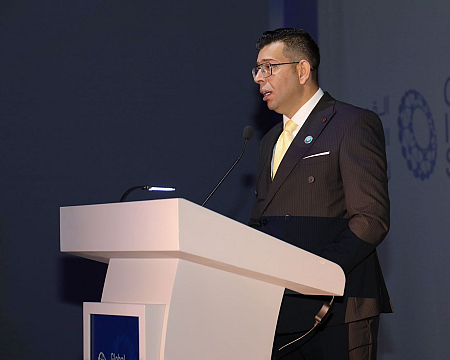عامل البناء الذي اصبح مستثمرا اقام شركة ناشئة والتي قامت بتطوير نظام يمكنة توزيع المهام ومرتقبة كل عامل في موقع البناء.

هذا المقال بالتعاون مع Geektime.
פועל בניין ישראלי החליט להפוך ליזם, ובנה אלגוריתם שגילה 20 עובדים שצבעו את המקום הלא נכון
הסטארטאפ שהוקם ע"י פועל הבניין שהפך ליזם עוזר לחברות הבנייה לחסוך כסף רב ע"י ניטור האתר בזמן אמת
יש הרבה דברים שיכולים להשתבש במסגרת תהליך הבנייה הארוך, מה שמוביל לחריגות בתקציב ולוח הזמנים של הפרויקטים. על זה צריכים להוסיף ניסיונות של גורמים שונים בתהליך לגזור קופונים ולהרוויח לא מעט שלא ביושר. אבל מנהלי עבודה לא יכולים להיות בכל מקום ובכל רגע נתון כדי לפקח על כל טפסן וכל משאבת בטון באתר, מה שגורם לא פעם להפסדים כספיים לחברות המבצעות. כאן נכנסת לתמונה מערכת ישראלית חדשה שעושה שימוש ברכיבי IoT וממשק ניהול ובקרה מרחוק.
מבינים איפה כל עובד באתר בזמן אמת
המערכת של הסטארטאפ הישראלי Genda מבטיחה להיות "מנהל אתר הבנייה הדיגיטלי הראשון"', והיא עושה את זה בעזרת מערכת לניטור מיקום של עובדים וציוד באתר, שמיועדת לחברות בתחום הנדל"ן ומנהלי אתרי בנייה. כדי לעשות את זה, מייצרת ג’נדה תמונת מצב בזמן אמת של הנעשה באתר הבנייה, ומצליבה את המידע מול התכנון כדי לייצר תובנות עבור מנהלי האתר. המערכת מייצרת בצורה אוטומטית מידע אודות מיקום משאבים ומשתתפים בפרויקט כמו עובדים וציוד, זאת ע"י שילוב של משדרי IoT ואפליקציה לטלפונים ניידים.
המידע מוצלב מול מקורות מידע נוספים כמו לו"ז הפרויקט, תקציב, מערכות ניהול הפרויקט ודיווחים מהשטח – המעובדים על ידי אלגוריתמים שפיתחו ב-Genda, שיכולים לזהות את התהליכים המתבצעים ומציפים את הנקודות הדורשות התייחסות של המנהלים בשטח. למרות זאת, כך מספרים לנו בחברה, המערכת לא דורשת תחזוקה או הכנות ומשתמשת בעובדים הנמצאים באתר: "המידע שאנו מייצרים משלב את כל מקורות המידע הזמינים כדי לזהות את צווארי הבקבוק בתהליך, ולאפשר זרימה חלקה של העבודה בפרויקט כך שהמנהלים בשטח יוכלו להתמקד במה שנכון במקום במה שאפשר", הסביר לגיקטיים ארז דרור, כשהסטארטאפ נחשף אצלנו במאי האחרון.
בשיחה איתנו מסביר שי לוי, ה-CTO ואחד מהמייסדים, כי במהלך כל פרויקט נפרשים מאות ואף אלפי משדרי BLE (בלוטות' בצריכה אנרגיה נמוכה) והאותות המשודרים נקלטים על ידי אפלקציה ייעודית המותקנת אצל הפועלים שמאכנת את המיקום של כל מכשיר טלפון או משדר שמותקן על ציוד נייד כדי לייצר עבור מנהלי העבודה את תמונת המצב בשטח.
"כל המידע הנאסף עובר דרך 'שער הכניסה' שכותב אותו לדאטה-בייס בזמן אמת ומסנכרן אותו לתחנה הבאה – שהיא מאגר big data המתאים יותר לניתוחים ולמידת מכונה. למאגר זה אנו קולטים גם מספר מקורות מידע נוספים (כגון תוכניות ולוחות זמנים). כל המידע משמש אותנו לטובת ניתוח והבנת רצף וקצב הבנייה, חיווים לחריגות בלוחות הזמנים, ופיתוח היוריסטיקות לקבלת החלטות", מסביר לוי.
הוא אומר עוד כי מרבית האלגוריתמים שמשמשים אותם כיום לעיבוד המידע התחילו בכלל כניתוח ידני שבוצע על ידי צוות האנליסיטים של החברה, וברגע שצברו מספיק ניסיון, צוות הפיתוח לקח את זה עליו להפוך את אותם ניתוחים לאוטומציות בתוך התהליך של המערכת של ג'נדה.
חוסכים הרבה כסף בעזרת "מנהל העבודה הדיגיטלי הראשון"
דרור מספר על מקרה שבו פועל ניסה לתבוע את אחת מחברות הבנייה שאיתן ג'נדה עובדת בטענה שנפצע באתר הבנייה. המערכת של החברה זיהתה כי הפועל אינו דובר אמת, בהתבסס על הלוגים שלה מאתר הבנייה, שהוכיחו שהוא לא היה כלל במקום בזמן שנטען, מה שהוביל לדחיית התביעה. מדובר בחיסכון של רבע מיליון דולר לחברת הבנייה שיכלו ללכת לפח אם תביעת העובד הייתה מתקבלת.
במקרה נוסף מספר לנו דרור כי יכולות ניתוח דפוסי העבודה גילתה כי צורת העבודה של קבלני משנה עלולה לגרום לחריגה בלו"ז, ולפגיעה באיכות העבודה. "המערכת התריעה לצוות האתר, שפנה לאותו קבלן וזיהה חריגות בצורת הביצוע, שהיו עולות מאות אלפי דולרים".
המערכת גם חוסכת עבודה כפולה ושעות עבודה מבוזבזות. במקרה אחד זיהתה המערכת כי 20 צבעים עבדו במיקום לא נכון, והתריעה על כך בזמן אמת. גם כאן נחסכו עשרות אלפי דולרים בהתחשב בעובדה שכל אותם העובדים היו צריכים לעשות עבודה כפולה אם היו ממשיכים כך. המערכת גם יודעת להתממשק למעלית המשמשת את הפועלים, ולחסוך פעולה של מפעיל, מה שמאפשר פעילות יעילה יותר וחסכון של מאות שעות עבודה שמיתרגמות גם כאן ללא מעט כסף.
"אנחנו עובדים עם אנשים אמיתיים באתרי בניה פיזיים ומנתחים דפוסי תנועה פיזיים של אנשים שבונים בניינים. צוותי הפיתוח שלנו מפתחים פיצ'ר שיום למחרת כבר נותן ערך לאלפי פועלים ומנהלים באתרי בניה בארה"ב. אותו הלופ ממשיך עם דרישות שעולות מהמשתמשים שלנו בשטח, תרתי משמע, ועולות לצוות האנליסטים שלנו שמנתחים דאטה של משתמשים אמיתיים שזזים בעולם האמיתי ומחזירים תובנות שמשפיעות על תהליכים אמיתיים" מספר דרור.
מגייסים ומתרחבים לארה"ב
Genda הוקמה על ידי ארז דרור, אייל קוליק (COO) ושי לוי (CTO), ויש לה כבר לקוחות משלמים בפרויקטים בארה”ב. הסטארטאפ הישראלי מרוויח ממכירת רישיון שימוש חודשי במערכת, המקנה למשתמשים רישות מלא של אתר הבנייה, גישה למוצר במובייל ובווב ללא הגבלה של משתמשים או מיקומים.
היום חושף הסטארטאפ גיוס סיד של 6 מיליון דולר בהובלת קרן TenOneTen Ventures והשתתפו בו הקרנות S3 Ventures ו-Jibe Ventures; קבוצת שיכון ובינוי; והאנג'לים יואב עמית ויאיר וינברגר שכבר הספיקו למכור חברות לגוגל ו-Wix. החברה אמנם עובדת כבר היום עם אתרי בנייה רבים בארה"ב, אך עם הגיוס המתוכנן היא גם תפתח משרד ראשון באוסטין.

An Israeli construction worker decided to become an entrepreneur, and built an algorithm that discovered 20 workers had painted the wrong spot
The startup helps construction companies save a lot of money by monitoring the site in real-time
Many things can go wrong during the long construction process, which leads to budget and schedule overruns. On top of this are the many people who try to cut corners and aren't the most honest about it. But site managers can’t monitor every movement on-site from the concrete pump to the building moulder and this often leads to financial losses for companies. This is where a new Israeli system comes into play that uses IoT components and a remote management control interface
Understand where each site employee is in real-time
The system of the Israeli startup Genda promises to be "the first digitally managed construction site", and it does this with a system that monitors the location of employees and equipment on the site; it is intended for real estate companies and construction site managers. To do this, Genda produces real-time snapshots of what is happening at the construction site and cross-references the information with the plans, to generate insights for the site administrators. The system automatically generates information about the location of resources and project participants, such as employees and equipment, by combining IoT transmitters and a mobile phone application.
The information is cross-referenced to other sources of information such as the project schedule, budget, project management systems, and field reports - processed by algorithms developed by Genda, which can identify the processes taking place and highlight issues that require managers' attention in the field. Yet, the company tells us, that the system does not require maintenance or preparation from the workers on the site: "The information we produce incorporates all the sources of information available to identify the bottlenecks in the process, and allow a smooth flow of work in the project so that field managers can focus on what is actually needed instead of what might be needed," Erez Dror explained last May when the startup was unveiled.
In a conversation with us, Shai Levy, the CTO and one of the founders, explains that during each project, hundreds and even thousands of BLE (Bluetooth Low Energy) transmitters are deployed and the transmitted signals are received by an application installed by the workers that calculate the location of each mobile phone or equipment to produce a snapshot of the situation in the field for the manager.
"All the information collected goes through the 'entrance gate' which writes it to the database in real-time and synchronizes it to the next station - which is a big data repository that is more suitable for analysis and machine learning. For this database, we also collect many additional sources of information (such as plans and schedules). All the information is used by us to analyze and understand the sequence and pace of construction, indications of deviations in the schedules, and the development of heuristics for decision-making,” Levy explains.
He goes on to say that most of the algorithms used today to process the information began as a manual analysis performed by the company's analytics team, and once they gained enough experience, the development team took it upon themselves to automate those analyzes within the Genda system.
Save money with the help of "The first digital manager"
Dror told us about a case in which a worker tried to sue one of the construction companies that Genda worked with, claiming that he was injured at the construction site. The company's system recognized that the worker was not telling the truth, based on its logs from the construction site, which proved that he was not at the scene at the time it happened, which led to the dismissal of the lawsuit. This is a quarter of a million dollars in savings for the construction company that could have gone to waste if the worker's claim had been accepted.
In another case, Dror tells us that the capabilities of analyzing work patterns have revealed that the work of subcontractors can lead to deviations in the schedule, and damage to the quality of work. "The system alerted the site staff, who contacted the same contractor and identified anomalies of execution, which would have cost hundreds of thousands of dollars.”
The system also saves working from being done twice and wasted working hours. In one case, the system detected that 20 painters were working on the wrong area and alerted them in real-time. Here, too, tens of thousands of dollars were saved given the fact that all those workers would have had to do double the work if they had continued like this. The system also knows how to interface with the elevator used by the workers, and save the operation of an operator, which allows for more efficient operation and saves hundreds of hours of work. This obviously translates to a lot of money being saved.
“We work with real people at physical construction sites and analyze the physical patterns of people who build buildings. Our development teams are developing a feature that already gives value to thousands of workers and managers at construction sites in the US. With growing demands that arise from our customers in the field, our team of analysts who analyze data of real users in the real-world return insights that affect real processes," says Dror.
Recruiting and expanding to the U.S.
Genda was founded by Erez Dror, Eyal Kulik (COO) and Shai Levy (CTO), and already has paying clients in projects in the United States. The Israeli startup sells a monthly subscription that licenses companies to use the system, which gives users full networking of the construction site with access to the product on their mobile or web devices.
The startup announced a $6 million seed fundraising round led by TenOneTen Ventures with participation from S3 Ventures and Jibe Ventures funds, different housing and construction groups, and investments from angel investors Yoav Amit and Yair Weinberger, who have sold companies to Google and Wix. Although the company already works today with many construction sites in the United States, with the capital from the fundraising they plan to open its first office in Austin.


كشفت دراسة جديدة نُشرت في مجلة NEJM AI عن تطوير نموذج ذكاء اصطناعي قادر على تشخيص مرض السيلياك (Celiac Disease)، والمعروف باسم الداء البطني، بدقة تضاهي الأطباء المتخصصين، بل...

أطلقت سلطة الابتكار بالتعاون مع وزارة العمل قاعدة بيانات محوسبة على الانترنت بعنوان "عرب تيك" والتي تتضمن...

فهد العملة : القمة العالمية للابتكار نجحت بإمتياز بحضور لافت وتوصيات هامة . * الشبكة العربية للابداع...

أعلنت شركة غوغل أنها ستتوقف عن دعم "Google Assistant" على هواتف أندرويد، مستبدلةً إياه بمساعد الذكاء الاصطناعي...

فاز فريق اشبال ج مكابي اخاء الناصرة بالديربي على نظيره هبوعيل نوف هجاليل بنتيجة 1-0تلامذه المدرب الواعد والشاب فارس مصاروة ومساعده الواعد والشاب محمد احمد ابو...

تايلاند هي الوجهة الأولى وتركيا ومصر خارج القائمة!* لأول مرة منذ بداية الحرب، من...

الشاب محمد توفيق سليمان ابن بلدة المشهد كفيف 100% نجح بان يتمم بصورة كاملة حفظ...

يتوقع الراصد الجوي أن يكون الجو، اليوم الثلاثاء، حارا وجافا في معظم المناطق،...

كشفت دراسة جديدة نُشرت في مجلة NEJM AI عن تطوير نموذج ذكاء اصطناعي قادر على تشخيص مرض السيلياك (Celiac Disease)، والمعروف باسم الداء البطني، بدقة تضاهي الأطباء المتخصصين، بل...

أطلقت سلطة الابتكار بالتعاون مع وزارة العمل قاعدة بيانات محوسبة على الانترنت...

فهد العملة : القمة العالمية للابتكار نجحت بإمتياز بحضور لافت وتوصيات هامة . *...

أعلنت شركة غوغل أنها ستتوقف عن دعم "Google Assistant" على هواتف أندرويد، مستبدلةً إياه...